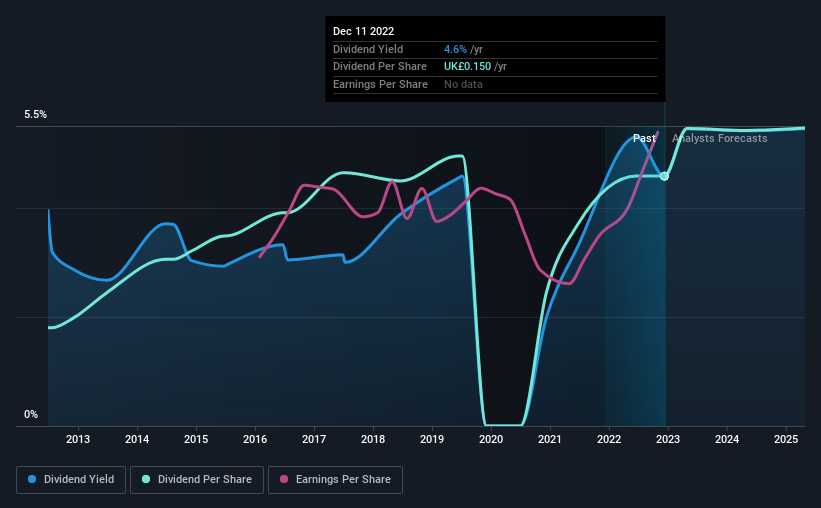Income Investors Should Know That DS Smith Plc (LON:SMDS) Goes Ex-Dividend Soon
DS Smith Plc (LON:SMDS) is about to trade ex-dividend in the next three days. The ex-dividend date occurs one day before the record date which is the day on which shareholders need to be on the company's books in order to receive a dividend. The ex-dividend date is of consequence because whenever a stock is bought or sold, the trade takes at least two business day to settle. Therefore, if you purchase DS Smith's shares on or after the 15th of December, you won't be eligible to receive the dividend, when it is paid on the 31st of January.
The company's upcoming dividend is UK£0.06 a share, following on from the last 12 months, when the company distributed a total of UK£0.15 per share to shareholders. Based on the last year's worth of payments, DS Smith stock has a trailing yield of around 4.6% on the current share price of £3.277. If you buy this business for its dividend, you should have an idea of whether DS Smith's dividend is reliable and sustainable. So we need to check whether the dividend payments are covered, and if earnings are growing.
Check out our latest analysis for DS Smith
If a company pays out more in dividends than it earned, then the dividend might become unsustainable - hardly an ideal situation. DS Smith paid out more than half (59%) of its earnings last year, which is a regular payout ratio for most companies. That said, even highly profitable companies sometimes might not generate enough cash to pay the dividend, which is why we should always check if the dividend is covered by cash flow. It paid out 22% of its free cash flow as dividends last year, which is conservatively low.
It's encouraging to see that the dividend is covered by both profit and cash flow. This generally suggests the dividend is sustainable, as long as earnings don't drop precipitously.
Click here to see the company's payout ratio, plus analyst estimates of its future dividends.
Have Earnings And Dividends Been Growing?
Stocks in companies that generate sustainable earnings growth often make the best dividend prospects, as it is easier to lift the dividend when earnings are rising. If earnings fall far enough, the company could be forced to cut its dividend. This is why it's a relief to see DS Smith earnings per share are up 4.4% per annum over the last five years. Earnings per share growth has been slim, and the company is already paying out a majority of its earnings. While there is some room to both increase the payout ratio and reinvest in the business, generally the higher a payout ratio goes, the lower a company's prospects for future growth.
Another key way to measure a company's dividend prospects is by measuring its historical rate of dividend growth. In the past 10 years, DS Smith has increased its dividend at approximately 9.8% a year on average. We're glad to see dividends rising alongside earnings over a number of years, which may be a sign the company intends to share the growth with shareholders.
The Bottom Line
Is DS Smith an attractive dividend stock, or better left on the shelf? While earnings per share growth has been modest, DS Smith's dividend payouts are around an average level; without a sharp change in earnings we feel that the dividend is likely somewhat sustainable. Pleasingly the company paid out a conservatively low percentage of its free cash flow. All things considered, we are not particularly enthused about DS Smith from a dividend perspective.
So while DS Smith looks good from a dividend perspective, it's always worthwhile being up to date with the risks involved in this stock. To that end, you should learn about the 2 warning signs we've spotted with DS Smith (including 1 which is significant).
Generally, we wouldn't recommend just buying the first dividend stock you see. Here's a curated list of interesting stocks that are strong dividend payers.
Have feedback on this article? Concerned about the content? Get in touch with us directly. Alternatively, email editorial-team (at) simplywallst.com.
This article by Simply Wall St is general in nature. We provide commentary based on historical data and analyst forecasts only using an unbiased methodology and our articles are not intended to be financial advice. It does not constitute a recommendation to buy or sell any stock, and does not take account of your objectives, or your financial situation. We aim to bring you long-term focused analysis driven by fundamental data. Note that our analysis may not factor in the latest price-sensitive company announcements or qualitative material. Simply Wall St has no position in any stocks mentioned.
Join A Paid User Research Session
You’ll receive a US$30 Amazon Gift card for 1 hour of your time while helping us build better investing tools for the individual investors like yourself. Sign up here

 Yahoo Finance
Yahoo Finance 
